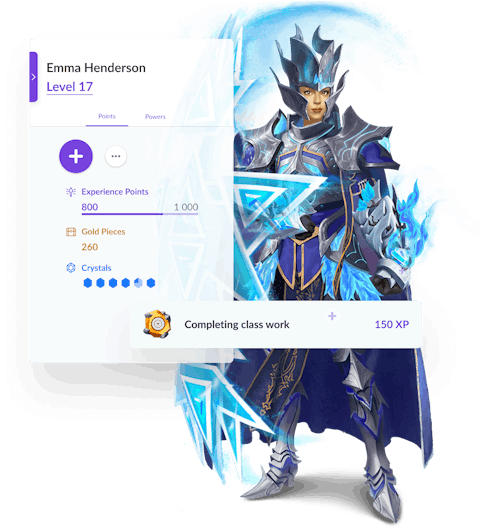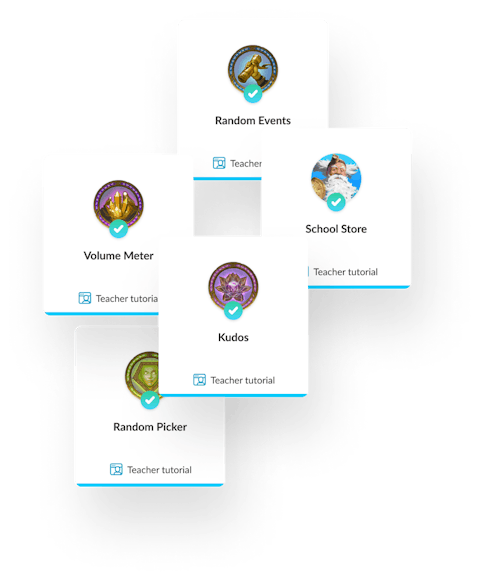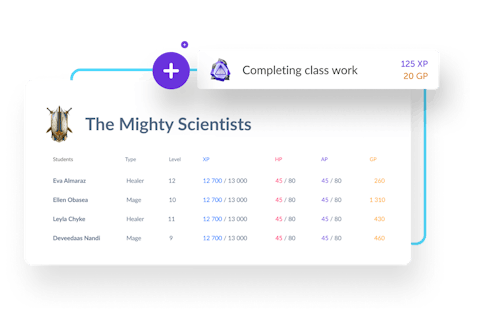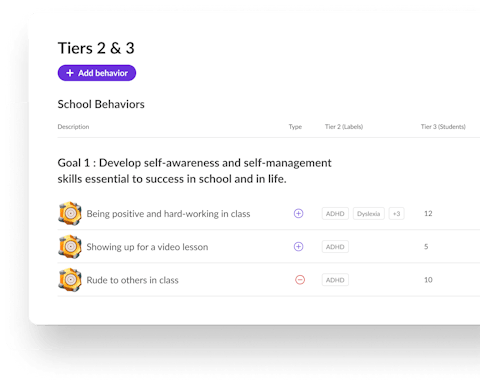A time-tested, modern approach.
Classcraft combines the principles of great pedagogy with an experience that meets students culturally.
From academic performance to SEL growth, student motivation with tiered intervention is critical to driving learning outcomes. Classcraft uses gaming principles to re-imagine students’ learning experiences and empowers them to reach their full potential.

The power of games
Driving learning outcomes through intrinsic motivation
Classcraft’s motivational approach is firmly rooted with the Self-Determination Theory, a well-researched psychological framework. By fulfilling players’ needs for exercising control, developing competency, and experiencing relatedness, external systems like gaming are significant pathways to foster intrinsic motivation.
By enabling educators to use familiar gaming mechanics in their instruction, Classcraft helps students see meaning in school and develop the competencies to become better learners. Classcraft’s features are all connected to developing different facets of intrinsic motivation and are highly effective at driving engagement. One study by UNC Charlotte showed student participation in online classes.


Games promote equity
Inequity manifests itself when students don’t have equal access to opportunity. Games, and Classcraft, are a true meritocracy – whoever a student is, regardless of race or gender, they have equal opportunity to earn points, level up and unlock powers and digital swag. Game points are completely egalitarian and build structure towards attaining opportunities. It’s true that some kids have relative advantages based on their background, but Classcraft is designed to help them improve regardless of their starting point. In gaming, there is no ceiling on what any child can achieve.
What’s more, because video games are often free, this cultural medium is equally prevalent across all social-economic groups [1] and is prevalent across all ethnic groups [2].
Kids love games
Games aren’t just a part of youth culture, they define it. In fact, gaming completely dwarfs every other cultural medium in terms of scale, be it films, TV, music, or professional sports. By creating a shared experience through games, Classcraft gives educators an authentic way to connect with students.


Collaboration > Competition
Competition and collaboration are powerful mechanisms with which to build intrinsic motivation. In an academic setting, competition can leave the losing students — often the ones who need additional support — feeling more demotivated and disengaged.
Classcraft takes a clear stance in promoting collaboration. By using a character class system, delivering classroom experiences that put collective experiences at the forefront, and making winning a team experience, we redefine the social dynamic in the classroom. The result? A more meaningful learning experience that supports teaching SEL competencies and builds stronger relationships between students and positive culture.
Effective tiered intervention made easy
Promote positive behaviors that align with your district’s biggest priorities
Classcraft’s behavior presets make it easy to develop skills and competencies by promoting positive behaviors schoolwide. Our approach aligns with well-documented practices like PBIS, MTSS and SEL – encouraging positive behaviour through gameplay mechanics such as earning experience points (XP) and levelling up. Using Classcraft, schools transform their behavior, SEL and climate initiatives into a game-like experience that’s all about celebrating wins.
- Choose a preset for standards like CASEL SEL competencies or remote learning standards for students — then customize it for your needs.
- Once you set Tier 1 behavior expectations at the school or district level, they sync to your teachers' accounts.
- This allows for best-practices in implementation leading to consistent application and reinforcement of Tier 1 expectations.
Because Classcraft provides a common language for discussing and recognizing positive and negative behaviors, student behavior completely changes, as evidenced in this case study.


Continuity matters: manage motivation seamlessly, either in person or remotely
Students disengage with remote learning because of a lack of intrinsic motivation, but also because they don’t know how to be good remote learners yet. This makes setting behavior expectations in remote education more important than ever. But which behaviors should we teach, and how do we do it?
Working with thousands of schools, Classcraft has developed the first set of standards for remote learning, based on 3 core skills:
- Being an Empowered Learner
- Being an Engaged Learner
- Contributing to the Learning Community
For each of these competencies, different behaviors with different mastery levels have been identified and are built into the platform.
Switching from in-person instruction to remote learning, or vice versa? With one-click, change your school’s behavior presets and sync the new behaviors with all of your teacher accounts.
Tier 2 & 3: Give your most at-risk students the support they need
Tier 1 interventions are the foundation of any tiered intervention initiative. But once you’ve identified students with Tier 2 or Tier 3 needs, how do you help teachers consistently support them?
In Classcraft, behavioral teams can:
- Support students with Tier 2 and 3 needs by identifying behaviors and strategies for their success.
- Assign appropriate strategies and behaviors to students and automatically sync them to all teacher accounts.
This allows teachers to reinforce specific behaviors for students with particular needs, while reinforcing Tier 1 expectations for their entire class.
What’s more, using Classcraft’s curriculum engine, Quests, is completely designed around RTI best-practices and differentiated instruction.

Data and analytics
Student-driven implementation gives you data you can use
Classcraft is student-centered, so it’s designed to generate a consistent flow of high-fidelity data that provides clear insights into student behavior and school culture. Most importantly, it shows you what’s working and what should be improved.


Better data, better decisions
The most effective behavior support is preventative and data-driven.
With Classcraft’s easy-to-use analytics tools, educators can go beyond simply counting referrals and gain a deeper understanding of how students are doing.
Reporting, made easy
Using pre-referral data — such as the number of exhibited positive behaviors — educators can track behavioral trends and identify the students that need more support as early as possible.